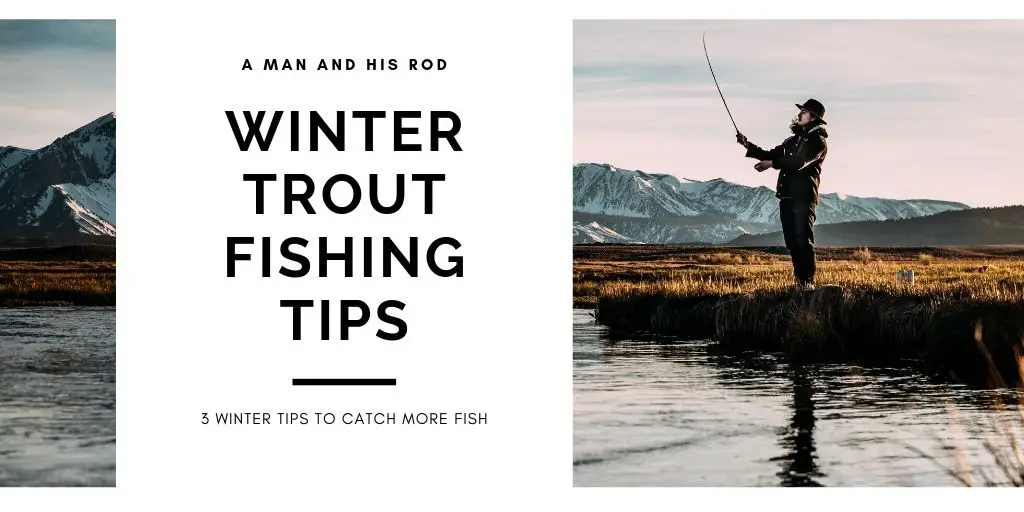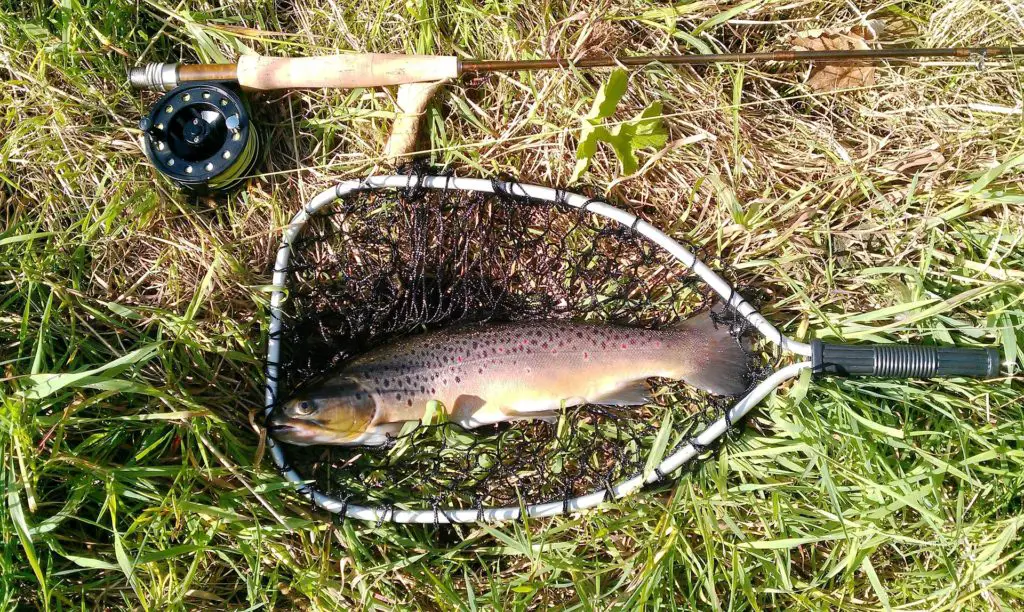There are many great lures, baits, and presentations to fish with when targeting bass. Knowing how to fish a spinnerbait makes for a fantastic option. A spinnerbait is an excellent moving bait that can be used in a variety of scenarios and situations.
Spinnerbaits are one of the stable mainstays in any bass angler’s tackle box. Their versatility and ability to cover a lot of water offers you incredible value. However, that value is null and void if you don’t know how to fish them.
There isn’t just one way or situation where a spinnerbait can be used. That being said, it is important to have a backlog of knowledge that can help you in the field and increase your hookups. Here is some more information about how to fish spinnerbaits for bass!
This website is reader supported. Any purchases you make through links on this site earn us a commission at no additional cost to you. Thank you for your support!
How Do Spinnerbaits Work?
Spinnerbaits are both simple yet versatile. The design is very practical and minimal but harbors very big results.
How do spinnerbaits work?
Well, that is a very common question from beginners, and it can be very beneficial to understand how these lures work.
Spinnerbaits are made from a thin metal frame that makes a V shape. On one end, there is the hook surrounded by a skirt. On the other, there are various add-ons like spoons or blades. Each side is as important as the other.
When you throw the spinnerbait out and start to retrieve it, the combination of the skirt and the blades gives a nearby bass the idea of a moving baitfish or pod of baitfish.
The skirt offers eye catching movement as well as a general color, and the blades provide flash and vibration.
Different blades do different things, we can cover this in just a moment. Here is a breakdown of the three main components of a spinnerbait.
Four Spinnerbait Components
When anglers want to select the correct spinnerbait for bass, there are four main components that should be considered. Each component is equally important and will factor into the lures ability to produce results for you.
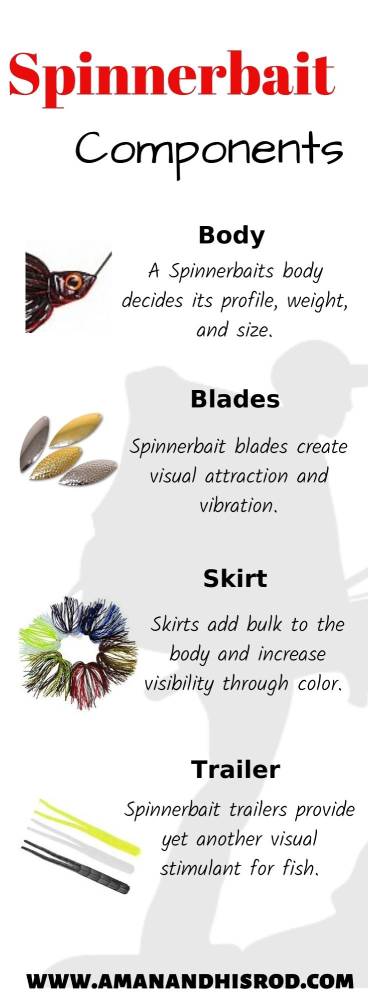
Spinnerbait Head and Body
The body of a spinnerbait decides its profile, weight, and size. The weighted shank is fixed to the wire frame and cannot be changed out.
With bigger heavier spinnerbaits anglers are able to get to deeper water faster. Smaller more slender spinnerbaits are used in finesse situations.
Most spinenrbait lures will have a head and a body. The head is the only part of the lure that the angler and the fish see since the body is covered by the skirt.
Spinnerbait Skirts
The skirt adds color and movement to the lure. Keep it simple here and use spinnerbaits that have nature looking colors. Stick to the whites, blues, purples, and chartreuse colors. These colors best imitate bait fish and will yield the best results.
One thing worth noting here is that skirts can be changed out. Finding a good reliable spinnerbait that has the perfect amount of weight, size, flash, and vibration is the hard part. Once these things are matched to the environment an angler is fishing, selecting the right color skirt to use is easy.
Spinnerbait Blade Selection
Finally, there are the blades. Depending on the size of the spinnerbait, you can have small blades or large blades. Blades are usually gold or silver to imitate the natural baitfish in the area. Blades can be any color in reality with white being the next most popular color.
There can be anywhere from 1-4 blades on a single spinnerbait. This is something that you will have to really examine when selecting the right spinnerbait.
Small blades create flash but not much vibration. Large blades can create both flash and vibration. Water clarity is the number one factor when selecting the proper bladed spinnerbait.
The three main types of spinnerbait blades are the Colorado, Indiana, and Willow Leaf.
A Colorado blade is closer to a circle than anything else. They resemble little spoons that are almost completely round. They create the most vibration of all other blades and are ideal when fishing muddy water or when bass fishing at night.
On the flip side, the Willow Leaf is sleek, slender, and long. These blades create the maximum amount of flash. This is because they spin quick around the wire shank of the lure with little resistance. Willow leaf blades are ideal for fishing clear water conditions or under the mid day sun.
Right in the middle of the two is the Indiana blade. This blade shares the best qualities of both the previously mentioned blades. It creates vibration and flash and is ideal for slightly colored water or moderately windy days.
Spinnerbait Trailer
This is where it starts to get fun when spinnerbait fishing. Finding that trailer that gives the perfect action for bass is the easiest part to swap out. There are many options to choose from but my favorite by far are the Zoom Split Tail and the Keitech Minnow. The split tail works for about 85% of situations. I will use the Keitech during spring and spawning situations because I like the bulkier profile.
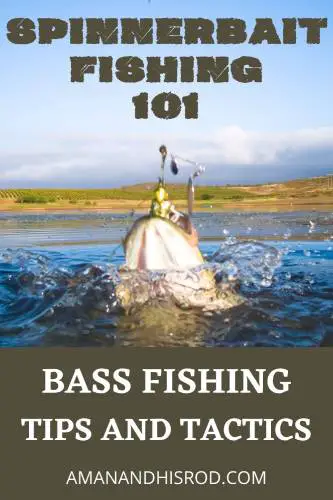
When Should You Use Spinnerbaits?
Possibly the biggest advantage to fishing with spinnerbaits is the ability to cover a ton of water fast. Spinnerbaits are especially easy to use effectively. They cast with ease, retrieve with little effort, and can be fished almost anywhere.
Windy Conditions
A great time to use a spinnerbait is when the wind picks up creating a little chop on the waters surface.
The water is creating a current that can make it difficult for bait fish to swim. This provides a perfect opportunity for hungry bass to lurk and hunt down their next meal. This is ideal because spinnerbaits are designed to replicate those same bait fish.
Another advantage to the windy days is water clarity. Wind disturbs the water creating less visibility for bass. This is done through current and waves crashing up on the shore.
Spinnerbaits are heavier than most bass fishing lures and can easily be cast through the wind. Where fishing rubber worms for bass may be hard in a wind event, spinnerbaits still get the job done.
Low Light Conditions
Low light conditions can turn a bite on in a hurry. Examples of this would be cloud cover, rain or snow, night time, or once again, dirty water. Low light does not offer fish a chance to thoroughly examine the lure. Bass only have one thing on their minds and that’s to feed. It is not instinctive for bass to allow a meal to just stroll on by, the bite first and get curious after.
Its’s worth mentioning here that mud lines in lakes present a unique opportunity for bass anglers. Positioning your body so that you can fish a spinnerbait right on the edge of the mud line can yield some great results. This is true for any bass lure, but the spinnerbait is my go to in these situations.
When Nothing Else Works
The third scenario for fishing spinnerbaits is simple, when nothing else is working. As stated previously spinnerbaits are great for searching our bass. You can drop the trolling motor and cover water, lace your boots up and cover shoreline, or drift in your kayak or float tube to cover water.
Fish your way through the water searching with a spinnerbait, changing colors, blades, and weights until the bass give us a sign. More time that not This is how I start most days when bass fishing from the bank.
Where to Use Spinnerbaits
Now that you know when to use them, there are some certain areas and things to look for when tying a spinnerbait on.
A huge perk of the spinnerbait is its ability to work well in both shallow and deep water. In the shallows, the blades hitting the surface is just like fleeing bait fish making a commotion. In deep water, it is just flashy enough to get the big bass lurking below to come out for a meal.
You also want to target structure. Bass live between rocks, in the brush, and under bridges or docks. All of these provide great spots for you to focus on. Often, people think that the perfect lure for throwing into structure is a jig. Jigs are great, but spinnerbaits can be very productive around these bass mainstays.
Don’t be afraid to get hung up, because when there is a high risk of getting snagged, there is often a high reward waiting below.
Generally speaking, shad love to live in rocky areas, especially ones with a rip-rap bank. Because spinnerbaits often resemble shad, this is the perfect scenario. So, look for rocky banks and rock piles under the water. These provide great points to work around.
Finally, look for points and cuts in the bank. When a bank comes to a point, each side of said point has a drop off. Bass love to sit in these areas and eat whatever comes over the edge.
When you’re throwing over a point, you are actually taking advantage of two drop offs, one on each side. The blades of a spinnerbait gliding over the edge of the cut and into the drop off is almost too good to resist.
RECOMMENDED ARTICLCE >> 5 BEST SMALL SWIMBAITS FOR BASS
What are some common spinnerbait techniques?
With any lure, there are certain techniques and styles of fishing that will help increase hookups. Although spinnerbaits are fairly fool proof, there are a couple of tips to make the presentation a little more appealing.
The first technique is known as “burning”. This is when you retrieve the bait as quickly as possible. This helps trigger a reaction bite from the bass and hopefully a hookup. Unless you are using a really heavy spinnerbait, burning it in will keep the lure at the top of the surface, causing a disturbance and looking scrumptious to a bass. When the bass are busting on topwater and you know they are fired up, this can be a great tactic.
On the complete opposite end of working a lure, there is slow rolling. This is when you let the spinnerbait fall in the water column and slowly retrieve it back in. With this technique, your lure will come in contact with any structure on the bottom and entice lingering bass. This is great for cold temperatures as bass will be far more lethargic.
It may seem a bit off-the-wall, but you can actually use a spinnerbait similar to you would a jig. Going back to the point about targeting structure, don’t be afraid to throw this in the same areas you would throw a swim jig.
Many anglers would think that spinnerbaits are not made for this type of presentation but think outside of the box and give it a try! A lot of anglers put spinnerbaits in a box that they can only be used in open water and in a certain way. This is not the case. You can’t be afraid to get hung up every now and then, but that is part of fishing.
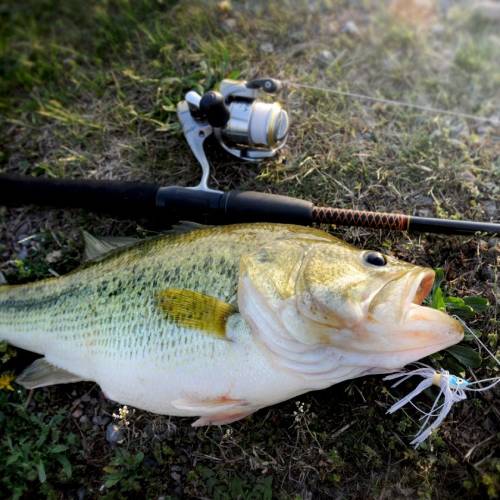
Can spinnerbaits be customized?
What a lot of fishermen don’t realize is that spinnerbaits can be highly customizable. Because of their simple design, it seems like customization wouldn’t be necessary and whatever is in the package is good enough. That is true, but there are some add-ons that can increase your chances of catching a trophy bass.
The best way to change a spinnerbait around to target big bass is to add a trailer. More specifically, paddle tail swimbaits are perfect for big spinnerbaits. This really takes the presentation up a notch and targets those big bass.
For smaller presentations, you can add a chunk or smaller swimbait to add some more subtle action. This can be just enough to fire up fish that are on the fence about striking.
The blades are other customization aspects of spinnerbaits. Although it really isn’t necessary for the average angler, you can buy separate blades and change them out. You may want to do this to upgrade them to a higher quality, replace them if they are damaged, or you are wanting a different length, color, or style.
Finally, spinnerbaits can be customized with the skirt. As you already know, this is a crucial part of the bait’s design. These skirts can be changed out after they are damaged, or you want a different color on a certain spinnerbait. However, you are probably better off by just buying multiple spinnerbaits that have different features.
A fantastic add on for both the skirt or the trailer is a liquid scent or color changer. A common option is Chartreuse ink that adds some flair to the presentation. Adding a garlic or coffee scent does basically the same thing and can increase your chances of getting bit.
Top Recommended Spinnerbaits
[amalinkspro_table id=”2187″ aff-id=”amanandhisrod-20″ new-window=”on” nofollow=”on” addtocart=”on” /]Final Thoughts
If you were unsure how to fish a spinnerbait before, hopefully this has showed you what they can do and how easy they are to manage.
These lures provide excellent ways to scan new water and find new fish. There is nothing more frustrating than getting skunked at a spot you have never been to before. Spinnerbaits are excellent for covering a lot of water and figuring out the hotspots.
Spinnerbaits are also great for scouting out structure and getting those finicky bass to come out and strike. You can’t be afraid of getting snagged or hung up because that is part of the process of catching those monster bass.
Also, you can customize your spinnerbaits and add a certain flair that falls flat normally. All in all, it comes down to you being creative, thinking outside of the box, and enjoying nature.
Hopefully you learned more about this awesome presentation and feel inspired to try it out for yourself. Happy fishing and good luck!
